Photo


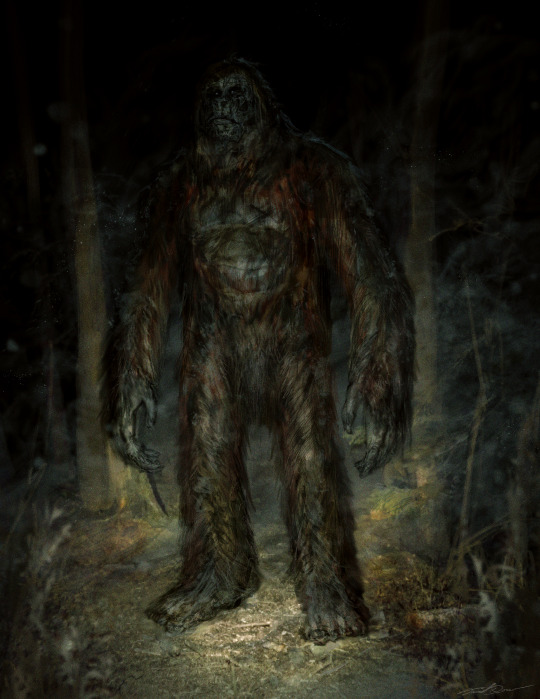
Alpha, Scout and Consort
From Max Brook’s Devolution
759 notes
·
View notes
Text
This is Maelle Forget, one of our more "docile" patient at the G.I.I's "Habilitation Centers". Although docile doesn't mean harmless, She's still a Vampire after all.


Hi! This is a teaser for something I'm currently Working on. A Scifi Horror Setting, with scientifically explanable Vampires, Werewolfs, Zombies, and much much more... This Setting started out as a Blindsight AU but the addition I made to the world, the Vampire biology, neurology, etc and a general desire to have more then just Vampires made me make this a separated setting (Althouth, Alot of aspects of Vampire lore was kept from Peter Watts amazing work, so yes, technically this is very much A Blindsight AU) other inspiration are from Though Potato's channel, like the whole idea of scientists researching cryptids and creatures and explaining the science. I also wanted to make it into Analog Horror but I certainly doubt my skillsets would allow me.
3 notes
·
View notes
Text
Dragons in a Trail of Cryptids

I don't care if this technically was posted in march i uploaded it to deviant art in time this is a february art post lmfao. This was meant to be a birthday gift for @jennywolfgal and her other project Trail of Cryptids. Enjoy!!!
The world of Trail of Cryptids explores an evolutionary history for life on earth. One in which the beasts of our folklore are more fact than fiction. Cryptids and mythological creatures exist and evolved naturally through both expected and unexpected origins.
One such group of organisms are the legendary dragons of countless tales of our world. Here they only recently diversified, but their ancestry dates all the way back to the beginning of the triassic.
Their earliest ancestor was a third offshoot of the Avemetatarslians, the same group of archosaurs that gave rise to the dinosaurs and pterosaurs. Ancient Silesaur-like Paradrakoans lived under their brothers’ shadows for the entire mesozoic period. Only scraping by through the smallest niches and farthest corners of the world like the equally unfortunate mammals.
Once the asteroid hit the earth 66 million years ago and wiped out the dinosaurs and pterosaurs. Only 2 representatives of this once great clade remained. Birds, and a single paradrakoan. A small burrower classified as Fodermasaurus superstes, cheekily named by paleontologists as the spug.
It took a long time for the Drakoans to grow their wings and spread it. At first climbing trees and making burrows, then gliding to ease the falls from the canopy. Then longer webbing on the hands to change direction. And finally learned to flap them to gain height. Countless now dead lineages, finally producing the first Drakoan over 40 million years ago during earth’s late eocene.
Nowadays the Drakoans are a fairly small group. They only consist of roughly 1,116 species. A far cry from their far more successful avian cousins. But nonetheless a monumental achievement relative to their entire evolutionary history.
Some common traits that distinguish the Drakoans from other vertebrates are developed egg-teeth that some species retain well into adulthood. Large auricles or external ears, Keratin horns. And most notably powered flight, evolving independently from their avian cousins.
We’ll start out with the order Avidrakoa. An order of Drakoans unique for possessing fully developed beaks derived from their egg teeth. And a unique wing structure made more out of fur bristles than a tough skin membrane. The Avidrakoans first split the moment the class as a whole first evolved powered flight. Allowing their wings to be this derived
They are not too common, numbering in 148 species in total. Most of which are split between basal bipeds such as thunderbirds and the more derived quadrupeds which include griffins.
The species here is an actual griffin. Gryphon tropicus to be exact. They are apex predators of the rainforests of indonesia. Their deep warm coloration and disruptive stripe conceal them in the forest scenery to ambush prey. And their powered flight lets them hop across islands, making them not only a formidable predator, but a widespread one too.
The most famous members of the Drakoan class are the Eudrakoans, the true dragons. They are characterized by their strong parenting mentalities and a natural ability to breathe fire. Through 4 orifices in the corners of their mouth they spew out a liquid biofuel into the path of a similarly regurgitated and highly reactive gas, igniting the fuel into a stream of flaming liquid.
They are the most widespread group of dragons, totalling at 447 different species. Most species are either small sprawling quadrupeds such as the European forest dragon to erect striding quadrupeds like the legendary Eurasian mountain Tsar
The species representing the True Dragons. Megaloros thereusicthys is a close relative to the Eurasian mountain Tsar. Although unlike their apex cousin this species is a wading piscivore. Using their stilted legs to practically hover over the water and their flexible necks to pluck fish out of the rivers they tread through.
Next up is the order Wyverna, a group of Drakoans distinguished by the development of poison laced quills found in certain places along the body. All interconnected to a set of poison glands in the upper mandible. These glands oddly enough share the same ancestry as the biofuel tanks in the Eudrakoans. And a stiffer wing structure making them obligate bipeds
They are the second most common order of dragons. Numbering at 335 documented species. Including the cockatrice surprising many.
The species pictured here is Ouranodyno chrysokephale. A generalist omnivore with a generalist range across Mexico with a rather extravagant hunting method. They dive-bomb towards their prey and catch them with their mouths. More as showmanship for mates than an actual means to survive. They also have extravagant coloration to warn would-be attackers of their poisonous tail quill that could kill a bison in under a minute
The order Neosauria is in a way, a twisted mirror of the beasts of the past. They are notable for a complete lack of wings. Reduced horns and aurica. But are most unique for their Theropod-like body plan as a consequence for their ancestor and their stiffer wings like their wyvern cousins.
They are a very rare order, the rarest order of dragons in fact. There are only about 62 species documented. Most of them are found across africa as smaller generalists. But a few can get big enough to recapture what the original dinosaurs had lost
Representing the Neosaurians, the Kasaii asymneter is a south african desert dwelling relative to the legendary Kasaii rex of the southern congo rainforest. They are both pursuit hunters and act relatively similar. The main difference is the prey selection and differenc coloration.
And finally there is the order Wurmiza, the most derived group of dragons recorded. They are distinguished by a near complete lack of hind legs. Fully internalized ears, a streamlined annelid-from body plan, and aquatic to semi-aquatic lifestyle. They are the 2nd rarest order of dragons. Consisting of only 124 documented species. Consisting of the smaller seafaring Ladons and the larger Oceanic sea Serpents.The species used to represent the Wyrms, Pachaktevenator horribilis. Is a medium sized sea serpent found in the Indian ocean. They are notable for their extreme aggression and their mating season being spent on the beach. Draconian elephant seals if you will.
66 notes
·
View notes
Text
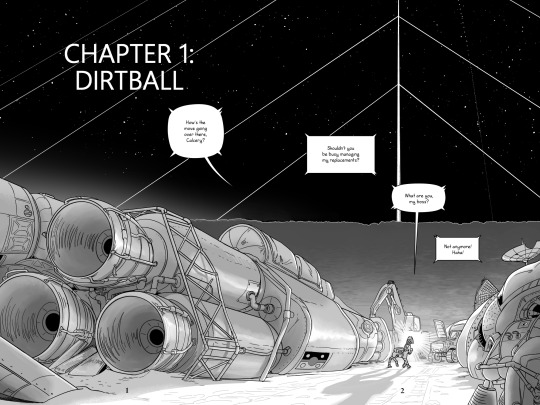


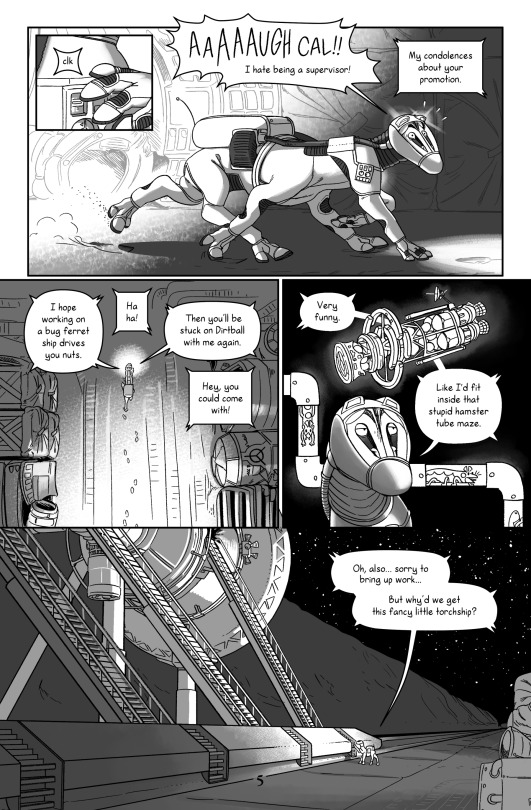
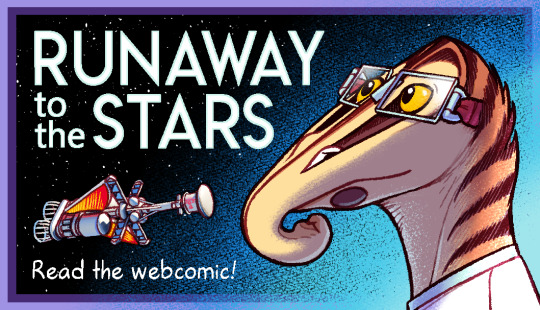
I finally (got help) slapping Wordpress into shape and Runaway to the Stars is now releasing as a public webcomic! Thank you so much for your support over the years, and sticking with me while I'm slowly chewing my way through this book. I'm very excited to share this story! It'll be updating every Tuesday, Thursday, and Saturday thanks to the massive Patreon backlog. Patreon will continue to update as I finish pages, which happens on a sporadic non-schedule.
If you experience bugs with the site report them to me. Some things may occasionally break, as coding problems tend to be a very "whack-a-mole" affair; and I'm still getting used to the interface.
7K notes
·
View notes
Text


Today in the shower, I was thinkin about werewolf anatomy and the pain/body horror that kinda transformation would actually entail 🤔 specifically the way a humanoid skull would have to stretch into a canine shape!! So I did a little study about it c:
2K notes
·
View notes
Text
Humans are adorable.
Supporting evidence:
1. Humans say ‘ow’, even if they haven’t actually been hurt. It’s just a thing they say when they think they might have been hurt, but aren’t sure yet.
2. Humans collect shiny things and decorate their bodies and nests with them. The shinier the better, although each individual has a unique taste for style and colouring
3. Humans are not an aquatic or even amphibious species, but they flock to bodies of water simply to play in it. They can’t even hold their breath all that long; they just love to splash!
4. When night falls and the sky goes dark, humans become drowsy and begin to cocoon themselves in soft, fluffy bedding.
5. Some humans spend time in each other’s nests! Just for fun! It’s not their nest; they’re just visiting each other.
6. Some humans use pigments and dyes to make their bodies flashy and colourful! They even attach shiny dangly bits to their cartalidgous membranes!
7. Humans are very clever, and sometimes adopt creatures from other species into their family units. They don’t seem to notice the obvious differences, and often raise them alongside their own young!
8. If a human sees another creature in distress, they can commonly be observed trying to help! Even at their own risk, most humans are deeply compassionate creatures!
9. If a human hears a particularity catchy sound or tune, it will often mimic it, even to the point of annoying themselves!
10. Sneezes are entirely involuntary, and completely adorable. Especially when the human in question becomes frustrated
11. Humans love treats!!! Some more than others. Many humans will save these treats specifically for a later date when they are in need of comfort or reassurance. IE, pickles, pop tarts, Popsicles, etc
12. They’re learning to travel in space!!! They can’t get very far, but they’re trying!!! So far, they’ve made it to the end of their yard, and have found rocks
451K notes
·
View notes
Text

Earthlings protesting conscription in Brisbane, 2029.
In the late 90's, the geteza (χetezɑ, ge-TE-za) and their allies started a movement called Earthlings. The primary goal of this movement was to blur the line between humans and geteza and to secure the future of their shared world.
Mieke de Wet (pictured) immigrated to Australia with her family in 2010, hoping for a better future. But as the cost of living went up and her parents grew ill, things grew dire. Mieke joined Earthlings in the mid 20's and took to the streets with them during the 2028-30 protests and riots against conscription.
76 notes
·
View notes
Text
Broke: xenophile
Woke: ayysexual
ayysexual /ˌeɪˈsekʃʊəl/ adj sexually attracted to aliens. ◻ n ~ person.
6 notes
·
View notes
Text
there’s an incredibly fun thread shaping up on /x/ today
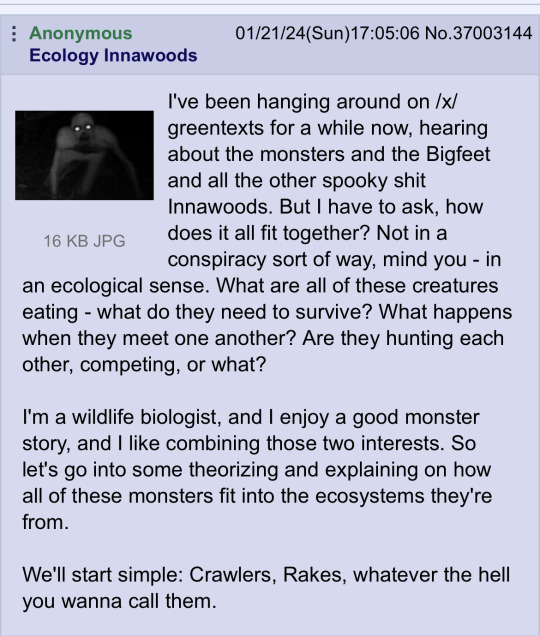


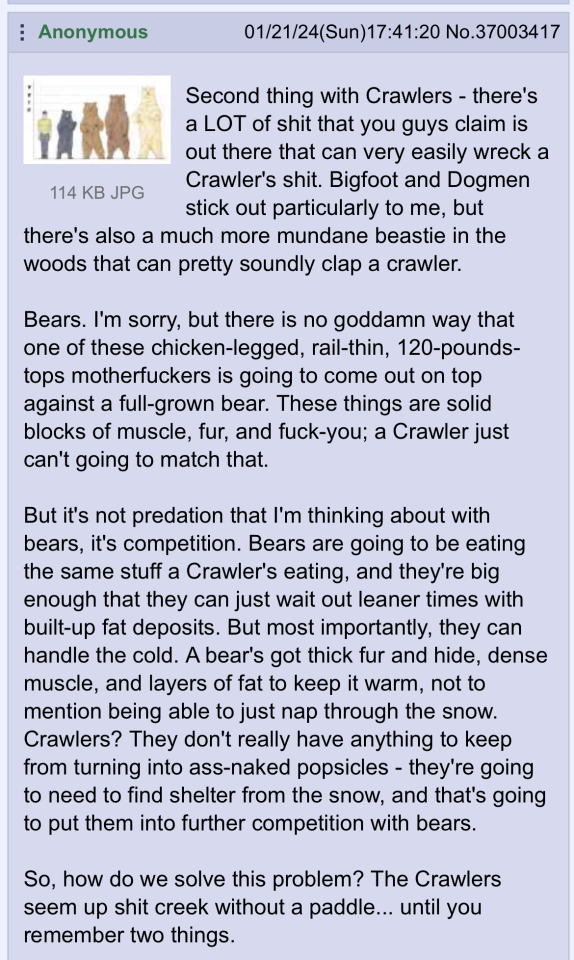
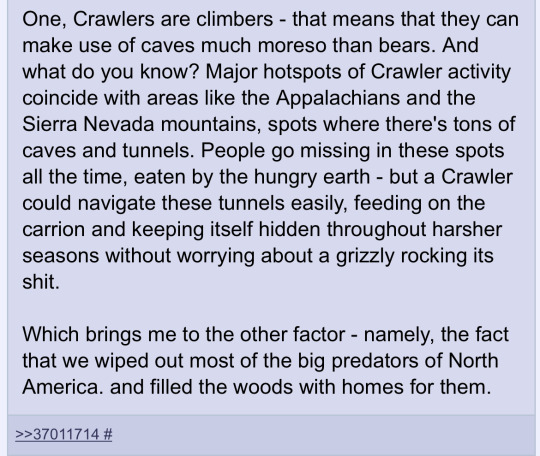
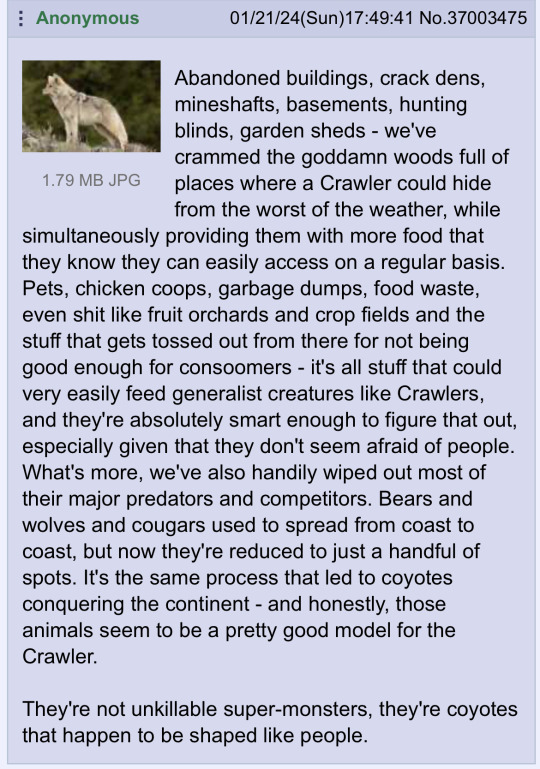
ecology of the Crawler
2K notes
·
View notes
Text
A short overview of humanity in my friend @jennywolfgal's project Star Odyssey

At the time of posting this it's her birthday right now. Everyone go follow her and wish her a happy birthday!
Pictured above is the flag of the Solar Republic flying over a green city on earth itself, each floor houses entire gardens, even entire forests.
Most of humanity as a species lives under the United Solar Republic, a direct democracy founded from the hardships of mistreated workers and splintered planet states eager to usher in a new age of cooperation and interplanetary trade
The solar republic would make contact with a gestalt civilization nicknamed the Foundation. We would go on to help them and several other alien factions win an interstellar war against the Brogzuk Empire. An xenophobic imperialist civilization responsible for the glassing of multiple planets and the enslavement of an entire species.
After our assisted victory against the brogzuk. We become one of the founding members of the Galactic Coalition of Worlds. An interstellar federation spanning half the milky way galaxy. Nowadays we are an interstellar superpower, sending exploration teams and diplomats to welcome countless fledgling species to the coalition.
While the republic's demographics are incredibly diverse thanks to being a major player in the interstellar scene. The majority of their population is primarily made up of Humans, Various uplifted species from Earth, truly sapient AIs, and a sophont alien species from the Teegarden star system named the Boh.
I have a HUGE backlog of art for her project so i hope you all enjoy the new sophonts I'll be posting in the future :)
26 notes
·
View notes
Text
“covered in blood” is an ideal state for a girl to be in if you see a girl covered in blood you know she is having a good time
35K notes
·
View notes
Text
The Six Lords of Ko-ve-dor, and an introduction to my friend's project Star Odyssey

One last art piece to end the year on a high note. It's an entry @jennywolfgal's sophont in her sci-fi / spec-evo / worldbuilding project Star odyssey. A far future where humanity and a few other advanced species help to found a Galactic Coalition of Worlds spanning half the galaxy. Everyone go follow her and check out her project!
I genuinley consider this atm my magnum opus in every aspect, Linework, Texturing, Coloring, Composition, and ESPECIALLY rendering.
The Commonality of Ko-ve-dor is an alliance between multiple sophont species evolving side by side on the same planet. All working together towards the prosperity for all denizens of the known galaxy.
Planet Ko-ve-dor, also known as Kepler-442 B, is a super earth in a 3 planet star system all orbiting a K-Type main sequence star known as O-uosa. Ko-Ve-Dor’s higher mass, larger magnetosphere, denser atmosphere, 3 moons, larger continents and O-uosa’s longer lifespan make Ko-ve-dor a superhabitable world. Capable of hosting more biodiversity than our own earth for a far longer time.
Plantlife on Ko-Ve-Dor is just as complex as it’s animal life and it shows. Most terrestrial flora possess a segmented exoskeleton that vary in shape and size akin to an insect. Most forms of plantlife exhibit both radial and bilateral symmetry in their overall body plan. Some species of Ko-ve-dor plantlife can even take in their surroundings with special segments that act as one big sensory organ.
And aside from some greenish phytoplankton, most flora on this world take on a red pigmentation to make the most out of its star’s dimmer light.
Not only is Ko-ve-dor more biodiverse than earth. But it’s greater abundance of life and more surface area means there's far more consumable biomass too. Allowing it’s animal life to reach greater heights and the option for greater brainpower. This paired with evolution’s trend towards more socialization. Means that sapient life has developed not once, or twice. But six times, all within a similar enough time frame for them to all interact with one another.
As each sophont species is a good representative of Ko-ve-dor’s kingdom of life. We will be skipping over the planet’s animal life to discuss their biology.
The Dor-Eø are the largest of the six sophonts and represent the planet’s many soft-bodied invertebrates. They take on a body plan very similar to earth’s flatworms. And being filter-feeders, they fill a niche not too different from whales. Their large carpet-like fins are actually enlarged partially external gills to aid in respiration. And they manipulate their environment with their two mitten shaped mandibles and opposable tusk thumbs.
They live in tight-knit nomadic pods where they ride the waves in search of plankton. They hunt said plankton like dolphins, continuously switching roles to either shepard the plankton and strike the condensed schools. And as they achieved sapience they’ve built nets to catch more plankton and dorsal fin flags to distinguish which pod they’re apart of.
The Dor-Ssri’ii represent a sapient species of aquatic, radially symmetrical fish analogs. They possess twelve eyes, with three on each side, a four sided jaw, and eight fins, four anterior fins and four posterior fins. Their intricate color palette helps them blend in with the yellow and red reefs.
They live in borderline eusocial schools where they manipulate their environment through their mouth like a tuskfish
The Ko-Ka’Kta are terrestrial relatives of the Dor-Ssri’cai, these are a sapient species of para-reptilian pack hunters native to the deserts and shrublands of Ko-ve-dor. They retain their radial symmetry and are quite basal compared to their relatives. Their forearms have atrophied into small rudders used by females to attract mates and live in matriarchal packs.
And they manipulate their environment with four highly specialized tongues. Their lack of claws or fangs pushed them to crafting an array of weapons to hunt. That and their hierarchical pack structure paved way for sapience
The Ko-A’atur represent the most derived group of Ko-ve-dor’s Vertebrates. Descending from a group that forgone their radial symmetry and became secondarily bilateral. Their heads hyper-elongated to the point where it’s now two separate body parts all together. Their lips have pulled back and became large flaps to cool off and express emotions.
Of all the sophonts they live the least socially, They forage and occasionally hunt in groups of 3-5 individuals. But the social bonds formed are so tight and complex that it managed to bring them up to sapience.
Onto life in the sky. The Ve-Huik are one of two representatives of Ko-ve-dor’s aerial invertebrates. They are a species of hexapodal invertebrate flyers protected by a sturdy exoskeleton. They fill a niche similar to parrots, capable of crushing nuts and fruits with their large mandibles that clench together like a fist. They live in small flocks and communicate by short whistles and hums. And they manipulate their environment with their remarkably dexterous six legs.
And lastly the Ve-Z’qi, a Is a seafaring relative to the Ve-huik, they are a sapient species of flying arthropod analogs native to the many coastlines of Dorveko. They live in nomadic flocks, hopping from island to island. They hunt their aquatic prey by looking for disturbances in the water before diving in to catch their target
Their history is one defined by sheer first contact and a long road to equality. The Dor-Eø and the Ve-Z'qi,a were the pioneers of exploration due in part of their nomadic lifestyles giving them a global range to freely explore. Slowly each species would suddenly learn the existence of their contemporaries and how to work with them.
Their society is egalitarian and very xenophilic, each species is born with full citizenship and everyone regardless of origin and identity are treated truly equally. yet their government is surprisingly autocratic. Each planet is ruled by a handfull of philosopher kings and queens who come from all walks of life. And are chosen by the state based on their view of life and understanding of the humanities. All to improve the lives of their people. They are also very welcoming towards outsiders, and have made themselves a beacon of liberty and safety for the galaxy's downtrodded.
With so many different sapient minds at work in a society that promotes harmony and teamwork. The Ko-ve-dor Commonality has advanced rapidly, being able to become a spacefaring civilization a thousand years before mankind. Their architecture and spaceships are large and bulbous, containing vast aquariums and spacious domes to accommodate all the different lifestyles. And have become one of the Galactic Coalition of Worlds' most important members.
Depicted here is a human diplomat posing with a friend group eager to take a photo with an unfamiliar face.
I'm happy i managed to get this out before 2024, though there still maybe work to be done, mainly to expand on their worldbuilding, and i hope everyone else has a happy new year!
160 notes
·
View notes
Text
If you do spec evo or spec bio, or just any kind of worldbuilding related to that, please reblog this post so I can follow you! I want to see beasts and creatures
178 notes
·
View notes
Text
Bestiary: Werewolf



Werewolves are large predators that're the result of a rabies derived virus dubbed TLV (Therianthropic Lupiform Virus) that overrides the afflicted host's genome into becoming a bloodthirsty killing machine, or kills them outright if proven too weak to survive. Being facultative bipeds, they find it quite easy and comfortable switching to bipedal and quadrupedal forms of locomotion, what isn't as comfortable however is the agony of the transformation, which in contrast to folklore, myth, and pop culture, is gradual and permanent. The sheer pain can be severe to the point where death is not an uncommon result, those that survive the ordeal however end up as formidable monsters that can scarcely be recognized as having once been Human, from the form of generalized hypertrichosis (the furred coat of infected match the host's original hair color and some outlines of the head hair can still be visible), to the growth of a mesocephalic snout that looks superficially canine, save for the lack of whiskers, philtrum, and rhinarium.
Obviously the laws of physics will demand for the infected to seek out copious amounts of protein to gain the mass for growth, often hoarding acquired unconsumed meats with them as they isolate themselves for later consumption to further complete their transformation. Similar to Vampirism and the Human Zombic Virus, the transformation's facilitated by the infected going into a comatose state, though due to the more drastic changes induced to the host's form, occurs during the later stages.
Despite their rabid bloodlust brought on by the virus and the high metabolic demands, thinking them all as mindless beasts can be proven a fatal error, especially for specimens that met and formed packs with other infected (whom they'll be neutral towards, even at recently infected who've yet to really undergo their transformation, passively ignoring them once sensing their condition, only lashing out if physically provoked or threatened), often displaying a frightening cunning such as targeting the wheels and engines of vehicles, or even power lines, satellite disks, and antennae.
While there's no known cure for Lycanthropy, there's nothing short of treatments that can at least ease the pressure, if not outright staving off the transformation process for months or even over a year, such as wolfsbane/monkshood with its sedative properties and silver, both of which are ironically used to slay infected in the past due to monkshood's high toxicity and the Werewolf's allergic reaction to silver.
Art was by the awesome talented AvesAdversary!
#cryptid#anthro#speculative biology#speculative evolution#werewolf#werewolves#werewolf art#lycan#lycanthrope
8 notes
·
View notes
Text
i do not care the werewolf designs for the quarry are literally perfect im SOOOOOO tired of designs just being a wolf head on a jacked body with a fluffy tail it honestly looks what i believe an anatomically correct werewolf to look like it even looks similar to my own designs from a year ago



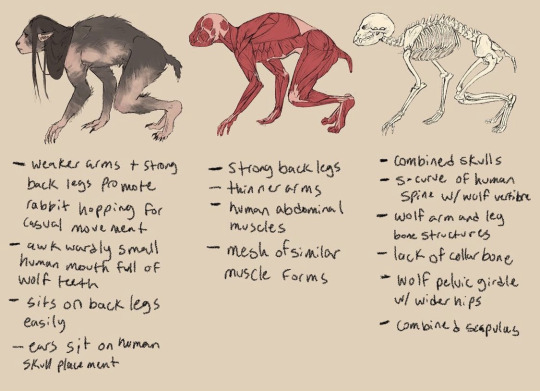
45 notes
·
View notes
Text
A to Z but even more based <3
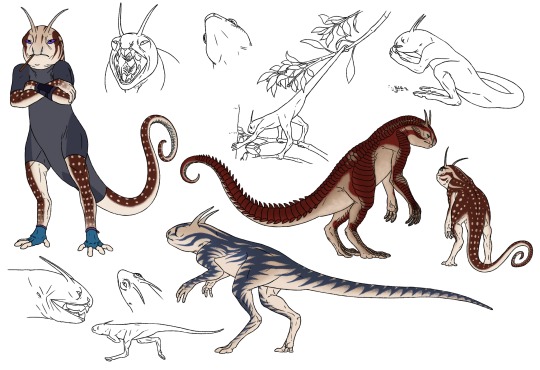
Some doodles of the hard sci-fi edition of the mollusc rodents, also including the other morphotypes.
33 notes
·
View notes
